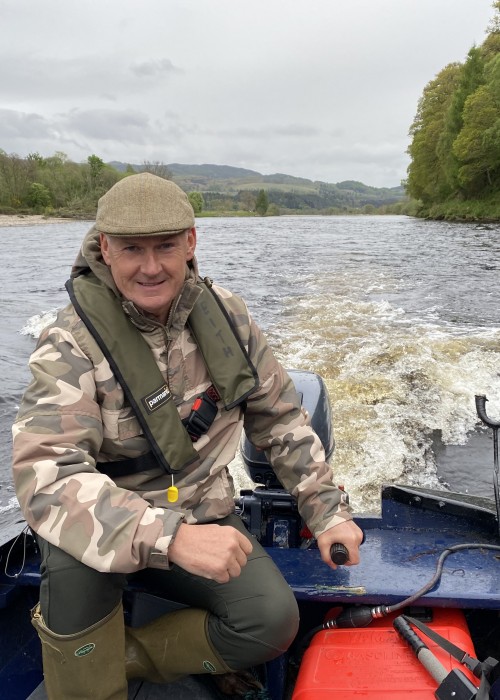
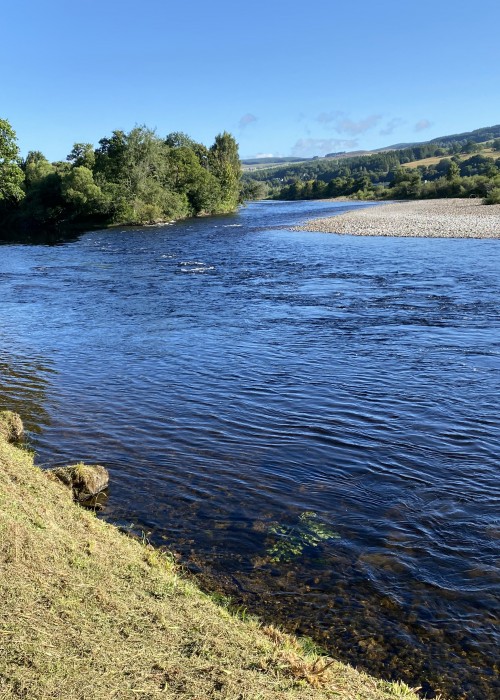
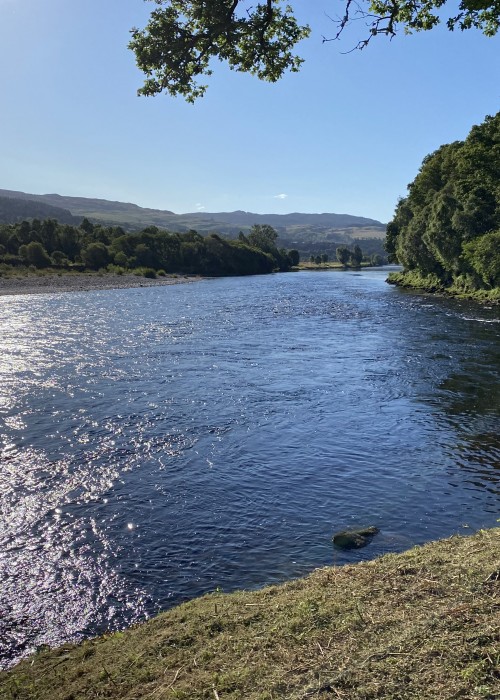
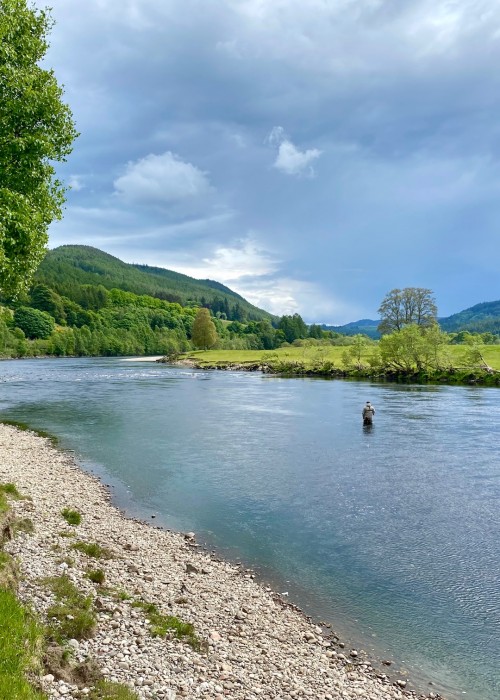
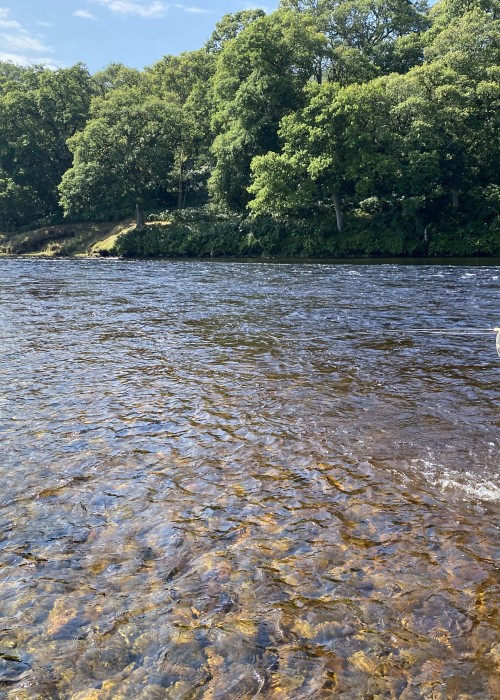
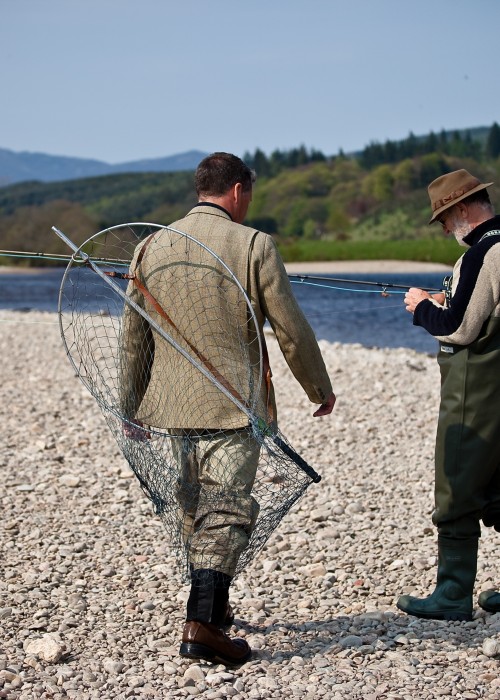
An insight into fishing for Atlantic Salmon on Scotland’s famous salmon rivers and useful information on where, when and how to fish for salmon.
Scotland is one of the world’s truly renowned salmon fishing destinations and is fortune to have in excess of 400 salmon rivers which are all in relatively close proximity to one another. This amazing migratory species of fish starts its humble beginnings in the shallower fresh water streams and pools of their native rivers where they can spend up to 3 years as juveniles before nature sends them to the rich feeding grounds off the Greenland Coast and the Faroe Isles. Salmon can spend anywhere from 1 year to 4 years feeding in the see before the urge to return to their native rivers begins and their journey home.
Nature has structured these runs of salmon to return in different cycles and many of the bigger Scottish salmon rivers have runs of salmon that continue through the Spring Summer & Autumn months each year. On the smaller West coast & Northern rivers the majority of fish arrive during the Autumn as often it’s the Autumn rains that provide sufficient water for these salmon to run. All the spawning starts when the first frosts appear during late Autumn so any river that has high ground in its headwaters will normally see the start of the spawning season sooner than the lower lying milder Scottish valley areas.
The Romans named this remarkable migratory fish Salmo Salar ‘the leaper’ as these fish are true masters at upstream navigation and will battle through some of the fastest flowing and turbulent waterfalls and river valley gorges nature can throw at them to return to their place of birth to start the Atlantic Salmon life cycle begins all over again.
Predominantly the bigger Scottish salmon rivers are well worth fishing for most of the year and River Tay salmon fishing begins on the 15th of January each year with a season that runs through to the 15th of October. River Dee salmon fishing in the North East Aberdeenshire area of Scotland opens on the 1st of February and runs through to the 30th of September with River Spey salmon fishing closing on the same September day but opening just a week later on the 11th of February. River Tweed salmon fishing in the South East is one of Scotland’s latest closing salmon rivers on the 30th of November and shares the same opening date each year of the 1st of February with the River Dee.
For those who are planning a salmon fishing trip to Scotland it is always best to consult a professional salmon fishing guide or agent who has served their time in the industry and who can build you a meaningful salmon fishing itinerary that can encompass a few different venues on a few different Scottish rivers to broaden and enrich your Scottish salmon fishing trip. During May 2017 as an example one of our American clients fished the River Dee & the River Tay during his Scottish salmon fishing break and caught a perfect fresh run River Dee Spring salmon and another perfect fresh run River Tay Spring salmon the day after changing salmon rivers.
The Northern & Eastern Scottish salmon rivers have fresh run Scottish Spring salmon in them from the start of their fishing seasons with the main Spring runs appearing when the water warms slightly after mid March. The Spring fishing is very special in Scotland as the absolute physical fighting qualities of these fish in the cold well oxygenated Spring water is renowned. The sub surface ‘glint’ off the flanks of a fresh run Spring salmon as it nears the landing net will stay in your mind indefinitely following the excitement of the cold water battle. As a former River Tay Head Ghillie I always loved to fish the Tay for a chance of a ‘Springer’ as they’re referred to locally and catching them is the ultimate Scottish salmon fishing experience. Any fresh salmon caught in Scotland between January and the end of May is commonly regarded as a Spring fish. In the last 10 years there’s been a big push in Scotland by myself and many other dedicated professionals to conserve Spring salmon stocks and the bi-product of these sterling efforts has definitely assisted in improving the number of Spring salmon in recent years.
The smaller rivers which predominantly are found over on the West Coast or the smaller tributaries of the Northern or larger East coast rivers fish best during late Summer spates and once the Autumn rains appear. Many salmon will enter the smaller West coast rivers on the first spate of the year and if you can time this correctly you’ll be in for some serious salmon & sea trout action. I recall fishing the West coast’s River Fyne as a boy after an Autumn spate and thought my eyes were playing tricks with me as the riverbed appearer to be moving in the pool I was fishing!
The ownership of Scottish salmon & sea trout fishing beats (venues) are usually privately owned as part of an individual estate’s assets. These Scottish salmon beats tend to be anywhere from half a mile to 3 miles in length and can include both riverbanks or just one side of the river. Often where you have two different owners on a beat the fishing area will be split in two and will be rotated on a daily basis and you’ll fish the Upper beat one day and the Lower beat the next day. All Scottish salmon rivers fall under the management of a District Salmon Fishery Board who take care of the policing of the river along with various conservation works whether it be running a man made hatchery or working on natural Atlantic salmon habitat enhancement projects or in some cases both.
Salmon fishing permit access is purchased directly from the owning estate or through a Scottish salmon fishing agent. There’s is currently no requirement unlike many other parts of the world where a fishing license is required in Scotland. When you purchase a Scottish salmon fishing permit on its own you are expected to have the correct salmon fishing equipment levels and some general Scottish salmon fishing tactical awareness to get value from buying the salmon fishing permit. For those who do not have the equipment or are in need of tactical salmon fishing tuition it is necessary to hire a professional Scottish salmon fishing guide who will provide the permit access, all the required salmon fishing equipment for Scotland including chest waders and a life jacket and tactical awareness to optimise your chances of catching salmon.
The cost of salmon fishing access on its own in Scotland can vary from £30 per permit per day to over £500 per permit per day. This big salmon fishing permit price range is mainly based on demand for a certain section of a Scottish salmon river which will be also down to historic salmon catches. This is where a professional Scottish salmon fishing agent can be worth their weight in gold by keeping you within the realms or reasonability balanced with the other attributes that make up a perfect Scottish salmon fishing experience. With guided Scottish salmon fishing prices start at between £450 and £495 per day which is inclusive of professional guide, all the required salmon fishing equipment and tactical tuition for those who need it. Approximately one third of the guided salmon fishing fee will be spent on the salmon fishing access and that money will be allocated to the best available venue within that price bracket based on the date(s) requested by the fishing client.
This is best qualified by asking yourself whether you would like to fish a smaller river with a shorter 9ft or 10ft single handed fly rod or whether you wish to fish on the larger Scottish salmon rivers with a 14ft or 15ft double handed salmon fly rod. Maybe a combination of both tactical approaches and river variance would be best for you which offers real Scottish salmon fishing diversification. This multi styled salmon fishing approach would suit the Autumn months best as most of the smaller Scottish salmon rivers don’t fish well until the late Summer or Autumn spates have occurred. The smaller Scottish rivers can be exciting and in many cases you’re sight fishing with a low stance and your polaroid glasses on. Once your eyes adjust to the water you’ll be able to see salmon and how they are reacting to your salmon fly as it swings past them. On the bigger rivers it’s a total different game and you’re relying more on your instincts as to where salmon could be holding or looking for one to show to give away their holding location. On the bigger Scottish salmon rivers methodical evenly spaced water coverage comes much more into play to position your fly in front of an often unseen ‘taking’ fish.
When I think central Scotland I always think of the mighty River Tay which is Scotland’s largest salmon fishing river. Draining a massive 2500 square miles of central Scotland the Tay always has sufficient water in it for salmon to run up river from the high tides at Perth where the Tay meets the North sea. The Tay also has an advantage in the fact that several big headwater lochs feed the river. Tay system lochs like Loch Tay, Loch Rannoch & Loch Tummel are but a few that create sustainable all year round fishable water levels which make this Scottish salmon river a safe bet as a fishing venue for for your salmon fishing trip. Follow this link for more information on guided River Tay salmon fishing.
Other world famous Scottish salmon rivers like the River Spey, River Dee, River Teith, River Earn, rivers North & South Esk and smaller well known rivers like the River Lossie, River Nairn, River Deveron and River Findhorn are other Scottish salmon fishing venues that can all offer excellent sport during your Scottish salmon fishing trip if timed correctly. Notable the River Dee offers great salmon fishing access on many spectacular salmon beats through the extensive Dee salmon fishing season of February through to September. The Dee is most definitely a gem in the crown of Scottish salmon fishing venues where fishing access fo experienced salmon fishers is readily available or a professional River dee salmon guide for those who are new to the sport or in need of assistance or tuition. Follow this link for more information on hiring a professional River Dee salmon guide.
The most dominant and famous Southernly Scottish salmon river is without doubt the beautiful River Tweed over in the South East corner of Scotland. The famous Tweed is a tremendous lowland Scotland salmon fishing venue where salmon can be caught all through the extensive Tweed fishing season from the beginning of February through to the end of November. Over in the South West of Scotland you have other famous salmon rivers like the River Annan, River Stinchar, River Doune, River Nith and the border River Esk. All of which offer great salmon fishing sport usually from mid Summer onwards. Follow this link for details of River Tweed guided salmon fishing.
A salmon fishing event dat on the famous River Tay makes for a highly memorable day out in some of Perthshire's most majestic natural beauty. Corporate salmon fishing events include the professional services of 'time served' River Tay guides and a fully catered riverbank lunch which is served in one of many luxury salmon fishing huts. Follow this link for more details on our bespoke Scottish salmon fishing event days.
In the North of Scotland we have some exciting possibilities too such as the often prolific River Brora, River Helmsdale, River Naver, River Sheil, River Thurso, River Forss, River Inver, River Conon, River Beauly and the River Kirkaig. These all have their days but tend to be more water dependent with the exception of the Conon & Beauly which have hydro released compensation water assistance on occasions.
Over on the West Coast of Scotland there’s famous Islands such as Skye, Mull, Lewis, Harris and South Uist and North Uist. All of these Scottish island have many small salmon and sea trout rivers which fish very well from the Summer months forward on the back of recent spate water. These rivers are very easily covered with a single handed fly rod and again it’s all about the timing of your visit.
On the bigger Scottish salmon rivers a 14ft or 15ft doubled handed salmon fly rod is imperative as a longer line lifting ability while Speycasting or overhead casting will be too difficult with a shorter fly rod. There’s also much more salmon fly control available with a longer rod when the fly is fished at distance. Working with a longer line (even if shooting additional distance) with allow you far more additional river fly swim time over the course of your salmon fishing day. When you hook a salmon at range there is also much less chance of the salmon drowning your fly line too which could easily result in excess pressure being put on the hook hold. On the smaller Scottish salmon rivers a fly rod of between 9ft and 12ft will cover all salmon fishing scenarios whether a short Spey cast is used or an overhead cast. A good strong leader and plenty of backing on your reel can be useful from experience when a hooked salmon decides to bolt downriver during higher water conditions.
It is very important prior to booking Scottish salmon fishing that you understand the difference between purchasing salmon fishing in Scotland and what that includes (or doesn't as the case may be) versus hiring a professional Scottish salmon guide which will also include the salmon fishing access to one of Scotland's better & pre-vetted salmon fishing venues. For decades Scottish salmon fishing agents have generally not made this very important point clear enough which is crucial for the enjoyment & correct qualification of your Scottish salmon fishing experience. Here's a link through to exactly what the difference is between purchasing salmon fishing access which includes the basic services of a beat ghillie (guide) and hiring the services of a professional Scottish salmon guide who will provide all required additional services.
The most effective and informative way to introduce a friend to Scottish salmon fishing is to purchase a fully guided & instructional Scottish salmon fishing gift voucher for them. This will ensure that they have a memorable day(s) on the either of the big four Scottish rivers Tay. Spey, Tweed or Dee with a professional salmon guide who will supply all of the correct equipment levels and necessary salmon fishing tactical tuition. This fully comprehensive service is especially popular as a Christmas salmon fishing gift voucher or general fishing gift for special occasions. A digital or hard copy of your guided Scottish salmon fishing experience gift voucher can be sent to you. The actual salmon fishing dates can be arranged after the gift voucher recipient receives their gift and suggestions can be made for Scottish salmon fishing accommodation & transportation at that point if required.
Having been involved in Scottish salmon fishing since 1970 one of the most important parts for success is knowing how to set the hook when a salmon takes your fly. As a former professional salmon beat head ghillie on the Tay in charge of several fishers on a regular daily basis I've witnessed great opportunities to catch salmon lost by fishers who fail in this very important discipline which is seldom properly discussed and in many cases left for the salmon to hook itself when it's objective soon into the contact will be to get rid of the fly.
My own advice when a salmon takes is never to lift into the take with a soft actioned rod and slack reel clutch setting as logically there's little or no hook point pressure applied from doing so. After ignoring the initial tugs at the start of the take and after several seconds of the fly line being drawn consistently off the fly reel simply clamp the fly reel face with your hand to stop the line flow dead to briefly feel the weight of the fish for a further few seconds.
Make sure the rod is pointing down in the direction of the fish when you do this in order to maximise direct hook point pressure from the reel to the hook. After feeling everything tighten up and the weight of the fish then release the reel and lift the rod. If this is done correctly and as detailed here your fish will be hooked properly regardless of where the initial micro hold of the hook points were positioned in the soft or tougher tissue within the salmon's mouth as it turned on your fly. Here's leading UK course fisherman demonstrating how he successfully hooked and landed his first ever Scottish salmon on the fly after several years of trying.
This effective hook setting method will allow the salmon's forward momentum & bodyweight to set the hook for you. In warmer Summer water the take will usually develop much quicker than the colder early Spring water. In colder water conditions allow a few more seconds before clamping the reel as the lower temperatures usually mean a much slower initial start to the take.
When you're fly fishing through a salmon pool it is good etiquette to take at least one good sized step between each cast and especially if there are other fishers present on either riverbank. Personally I move 3 feet between each cast to separate each swing of the fly by a yard. Less than that shows the salmon too much of the fly and any more may miss a hot spot in the pool. The less you show a fish of the approaching fly to my mind works better than training a fish to accept the presence of the fly in the pool.
What you're looking for is a reaction from a salmon and startling a fish that hasn't had the opportunity to get used to an approaching fly is more likely to have the desired effect. Adopt a sense for what speed and depth your fly is fishing at and don't just cast and hope. Adopting this mindset of how your fly is fishing coupled with good fly swing spacings will catch you more salmon.
If you're fishing a sink tip and wish it to work optimally apply your downstream movement on the forward delivery as the fly lands on the water and simultaneously throw a big upstream mend. By the time your line tightens and the fly starts fishing you'll have got your fly down to the desired swim depth.
In addition to these fly swim tactics keeping the rod tip extended out and high for the first third of the swing and gradually bringing the rod angle round as the fly fishes toward the riverbank will give you that added fly swim control for the first third of the swim. This little adjustment can often be the difference between a take or not especially when you want to slow up a fly out in a faster stream and at distance.
When playing a Scottish salmon it is important to keep the rod tip as high as possible and maintain reasonable rod pressure on the salmon throughout the fight. The high rod position will also act as a shock absorber and safeguard against any sudden movements from the salmon and it will also keep the line away from any sub surface obstacles.
The best position to take on the riverbank while playing a salmon is from a side on position. Don't allow the fish to get too far below you and if a salmon takes off down river then walk down the riverbank after it. When playing a salmon always be looking for an appropriate landing area for the final stages of the fight where there's deep snag free water which is out of the main current.
Never attempt to play a salmon in fast heavy water as it will use the water pressure to its advantage and kite about and take forever to land. Never attempt to rush a salmon to the landing net and always wait until the fish starts to tire and shows signs of fatigue which are indicated by slower movements at close range and showing its flanks and tail.
Hold back with the landing net until the time is right and place the net down in the water and draw the salmon over it and lift the net. Don't try to snatch at the fish as usually even a fatigued salmon will get startled and bolt quickly in that instance. Unhook your salmon in the landing net and in the water to avoid injury to the fish prior to release.
Most mobile phones these days have an excellent HD camera built into them so if you land a salmon please take a good shot of it. A photograph is always a nice memento of the encounter so a mobile phone (or camera) should be carried at all times. Make sure your device is kept in a waterproof pouch to keep it safe from water penetration.
If photographing a salmon while fishing alone make sure the fish is lying flat in the bag of the landing net with the salmon perfectly in frame on or close to the water line. Take a few shots to make sure you get a good one. Try to avoid contact with the salmon at all times.
If you're fishing with a colleague briefly lift the salmon to the water line in the landing net with the salmon's flanks as square to the camera as possible and have your colleague take a few shots. Sometimes tilting the belly of the fish up slightly by lifting the net's mesh will capture the beauty of the salmon's flanks more effectively. Again try to avoid contact with the salmon at all times.
Sunlight is always best behind the camera and ideally with the pool where it was hooked behind you and a big smile which should be easily achieved!
Always carry a pair of artery forceps which is the best tool for unhooking salmon quickly & efficiently with. These should be kept on a spring loaded retractable lanyard and clipped onto your fishing jacket for ease of access when required. Ideally unhooking a salmon should be done while the salmon is still in the landing net and in the water.
When releasing your salmon find an area of the pool that has a nice steady flow in a foot or two of water and once the fish has recovered release it directly from the landing net by lowering the net's rim and let the salmon swim out itself. If you have to handle the salmon to revive it pre-wet your hands and hold the fish with its nose to the stream for as long as it takes for you to feel the fish trying to pull away. This can sometimes take a few minutes but there's a great sense of satisfaction from seeing your Scottish salmon released correctly and swimming away strongly after the excitement of the capture.
It is customary in Scotland and good salmon fisher etiquette to tip your guide at the end of each fishing day regardless of whether you've been successful at catching salmon or not. There's a lot of hard 'life consuming' work involved in maintaining a salmon beat and professionally hosting salmon fishing clients which these 'special men' have comited their lives to.
The professional approach from the career ghillies of Scotland is essential for the overall enjoyment of Scottish salmon fishing and the magic that surrounds this wonderful pursuit. The daily tip should be between £20 & £40 per fisher however if you feel a larger tip is deserved for whatever reasons feel free to act accordingly.
The significance of the rod position instructional numbers pertain to the hour hand clock positions. Always starting with the clock face in front of you then rotating the clock face either downstream or upstream mid cast depending on whether you are practising the Scottish Single Spey Cast (upstream rotation) or Double Spey Cast (downstream rotation);
All Speycasting tuition should be conducted with sunglasses or safety glasses for eye protection and a piece of wool to simulate the weight of a salmon fly. Lifejackets should always be worn at all times.
With the Monteith fly lines this teaching method works best with the black head marker positioned between the cork handle and the first butt ring. Alternatively with any other Spey line or Shooting head system find the correct weight of casting head length so that feeling the load prior to the forward delivery cast is possible.
With the single Spey cast (from the right hand bank of the river) follow these exact rod positions; 4 oclock, 1, 11, 1 left hand up (upstream anchor) or the 4, 1, 11, 1, 11 right hand up (downstream anchor) with the double Spey cast from the right hand bank of the river. Alternatively (from the left hand bank of the river) use the 8, 11, 1, 11 right hand up (upstream anchor) for the single Spey cast or the 8,11,1,11,1 left hand up (downstream anchor) when using the double Spey cast. The left of right hand bank is deterred by looking always in a down stream direction only.
It is of crucial importance while following these rod position numbers and that ’smoothness of lift and swing’ builds up the line energy by keeping everything taught prior to the anchor point and immediate following power stroke. These exact rod positions as per the giant (hour hand only) clock face in the sky method which always starts in front of the fisher and rotates either upstream or downstream mid cast depending on which Spey cast is being performed.
This simplistic method gives you easy reference points for the important rod positions which are 1/3rd of what you need to know. The other 2/3rds being ’smoothness and fluency’ of lift and swing & ‘watching the anchor point’ to achieve good visual timing off the water and therefore not relying on guesswork while wading down through a pool in inevitably different altering depths.
It is crucial that you watch the anchor point so that you catch the timing correctly so the line lifts off the water. Too many Spey casters only look to the target area (like racehorses with blinkers on) and inevitable guess their timing off the water instead of getting a visual confirmation for when the time is exactly right for the forward power stroke delivery cast. The anchor point positioning should be approx 1 rod length off either shoulder depending on which one of the casts you are performing.
On both double Spey casts it is crucially important not to overpower the vertical lift or outward swing with the rod when moving between cast position numbers 1, 2 & 3 to either rod position 11 or 1 so as to make sure the fly stays in the rough downstream anchor point area (1 rod length away) prior to the in swing which creates the important loading. This is a common double Spey casting error as most people feel compelled to flick the fly away upstream of the intended downstream anchor point zone which is counterproductive and reduces line energy build up significantly prior to loading with the in-swing.
On both single Spey casts it is very important to spread the swing energy smoothly & evenly between 1 & 11 or 11 & 1 depending on which side of the river the single Spey cast is being performed from. Slow down on the swing or speed up as required until you are evenly spreading the correct amount of swing energy in order to achieve a straight line anchor point positioned one rod length off either your right or left shoulder. The same goes for the in-swing energy on a double Spey cast between 11 & 1 and 1 & 11. At no time during this movement should a ‘flick’ be used but only a steady, smooth evenly paced energised draw.
If you are ‘smooth & fluent’ enough with the lift and swing on all 4 Spey casts you should start to get consistent with the positioning of the anchor point (ideally 1 rod length off either shoulder) and should start to achieve a straight line anchor point on the surface of the river prior to the end of the fly line’s release (forward delivery cast) to the target area. If you are watching the anchor you'll be able to judge the exact & precise time off the water for yourself and track back to work out what’s going wrong if you are not consistently achieving this straight line anchor point in the correct position. Don't be a race horse with blinkers on as watching the anchor point tells you so much about your lift & swing.
Understand that on the single Spey casts there is a defined turning point in the sky at 11 or 1 at the top of the lift when the rod tip moves from the vertical lift (parallel to the riverbank) to an outward swing angle in order to keep the fly away from you as it passes between position 2 & 3 of the cast. Make sure you understand why this is so important for safety reasons and that it is important too with the double Spey casts so as to keep the fly away from you as it passes on its way to the anchor point position.
Understand that the outward swing should not dip but instead consistently hold its outward rod angle height throughout the swing. If necessary to briefly pause the rod precisely at 11 or 1 in order to change the rod angle at the top of the lift as it moves onto the swing angle range.
As importantly make sure you are slowly lifting your hands during the lift so that your bottom hand is up level with your chin as the rod reaches the 11 or 1 o’clock position as this lifting of the hands if done slowly and smoothly (between 4 & 1 or 8 & 11) always draws more line up to the surface/air which make the swing more controllable and easy for them (less line water resistance but only if done smoothly & slowly).
Each different Spey cast is used primarily for safety reasons depending on the wind direction and anchor point space availability. In other words if the wind is blowing upstream or downstream you would only use the single or double Spey cast that can achieve a down wind anchor point position. This way the salmon fly cannot be blown into you on the forward power stroke delivery.
During all casts your body position should be facing the target area and not at a downstream angle where it is going to be more difficult to achieve a correct anchor point due to the unnatural twisting of the upper body to compensate for an incorrect downstream body angle. Follow this link for more useful & logic based information information on the traditional Scottish Spey cast.